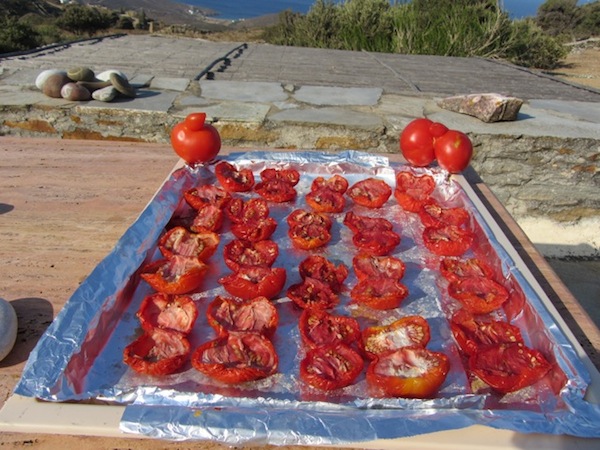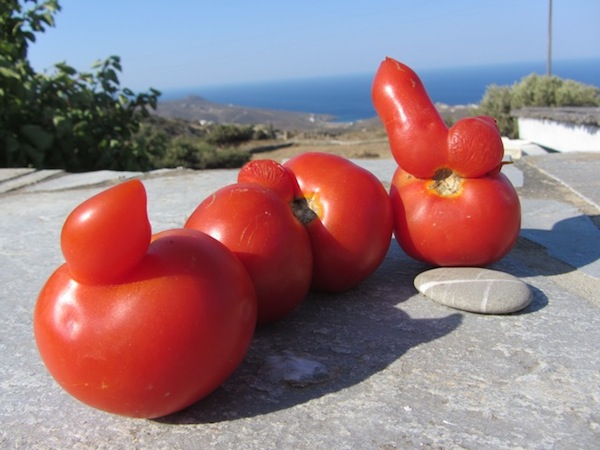Give Us This Day Our Daily Tomato

Eating Well Is The Best Revenge
By Diana Farr Louis
“Sometimes it seems as though I’m a summer slave to the pomodoro—so christened by the Italians because the first tomatoes to hit their shores were as yellow as gold but resembled apples. I buy almost more than I can carry for sun-drying, chutneys, and tomato paste.” Diana Farr Louis
 ANDROS Greece—(Weekly Hubris)—9/16/2013—I don’t think a day has gone by in the past three months that tomatoes haven’t been part of at least one meal if not two here. Lunch is invariably a tomato salad, with or without trimmings—onions, peppers, purslane, basil, capers, but not cukes, which stay neither crisp nor cool when mixed with the rest. Or so my husband, “Joy of the People,” maintains. And I oblige, unless the salad is liquid, as in gazpacho.
ANDROS Greece—(Weekly Hubris)—9/16/2013—I don’t think a day has gone by in the past three months that tomatoes haven’t been part of at least one meal if not two here. Lunch is invariably a tomato salad, with or without trimmings—onions, peppers, purslane, basil, capers, but not cukes, which stay neither crisp nor cool when mixed with the rest. Or so my husband, “Joy of the People,” maintains. And I oblige, unless the salad is liquid, as in gazpacho.
But our suppers usually contain tomatoes too, since hardly a dish slides into my lazy mind these days that doesn’t call for some form of this wonderful fruit. Make your own list: peperonata, ratatouille, baked summer veg, eggplant casseroles, stuffed toms, anything stewed with olive oil (our Greek laderá dishes), pasta sauces, and so on.
And if I have a hankering for something simply green without red over- or under-tones then, apart from zukes or amaranth (vlita), it’s probably not available from our farmers. Even string beans and okra don’t appear too often and, if they do, I’m tempted to throw in some tomatoes while cooking them.
Sometimes, it seems as though I’m a summer slave to the pomodoro—so christened by the Italians because the first tomatoes to hit their shores were as yellow as gold but resembled apples. I buy almost more than I can carry for sun-drying, chutneys, and tomato paste, which brighten up many a winter meal. At 50 cents a kilo, straight from the farm, it’s easy to go overboard.

But by mid-September, my fingernails stained orange from chopping pulp, I call a halt. The plants themselves are getting tired, too; leaves withering, fruit smaller and taking longer to ripen. As they give up, I praise them, thank them, and rip them out for the compost bin . . . sadly, remembering the excitement of planting the little shoots—also found sprouting in the compost bin—last May and June.
Tomatoes occur in so many Mediterranean recipes that we take them for granted, forgetting that their introduction into our diet took place relatively recently.
Although the Spaniards brought them back from Mexico in the early 16th century, the first seeds arrived in Greece in 1818. All we know is that the initial importer was, improbably, a Capuchin monk, Friar Francis (or perhaps François), who may have planted them at his monastery, which was attached to the Lysicrates Monument in Athens. That building, no longer standing, enjoyed enduring fame for hosting Lord Byron on the poet’s first visit to the city. But there the story ends . . . with no salsa.
Because they belong to the nightshade family—solanaceae, like potatoes and eggplant—Greeks didn’t add them to their stews overnight. Indeed, nothing more was heard of the plant until the mid-1800s, when travelers noted its cultivation on the islands of Syros and Santorini. The earliest recipes appeared in women’s magazines in 1885, but some of the more remote mountain areas remained ignorant or suspicious of the tomato’s red color and sweet yet acidic taste until after World War I.

But let us not be too critical of the rural Greeks. When Thomas Jefferson added tomatoes to his vegetable patch in Monticello in 1781, Americans didn’t rush to copy him, either. By the time the Supreme Court declared the fruit a vegetable, in 1893, they were hooked.
Why the Court got involved had to do with import taxes: fruits were not taxed but vegetables were. Botanically speaking, the tomato is a fruit, but the justices overruled botany in keeping with “common parlance” or customs and custom (http://en.wikipedia.org/wiki/Nix_v._Hedden). Since the tomato was treated as a vegetable, i.e. not eaten for dessert, it would be considered as such. But confusion reigns where the tomato is concerned; even its name results from a mix-up. The Spaniards missed out a syllable. When the Aztecs fed it to the Conquistadores, they thought they’d called it tomatl, which means any plump fruit, whereas they were saying xitomatl, this edible fruit.
Its scientific name, though, is Solanum lycopersicum, which translates as “wolf peach.” This derogatory term reflects the misconception that, because of its kinship with the solanaceae or nightshade family, consumption of it might be suicidal. In contrast, the tomato couldn’t be more wholesome (for most people), because it contains lycopene, which is one of nature’s most powerful antioxidants and may protect us against many kinds of cancer.
But never mind the history and the science. Isn’t it wonderful that something so incredibly common could still be so prized and loved? My own admiration for it, however great, will soon be put on hold until next June. I have eaten enough tomato salads to last me through the winter, and I never cease to be amazed by the sight of Greek shoppers at our farmers’ markets buying the fruit—pallid and watery from the hot house—in mid-January.
They have forgotten the Greek folk saying: “Kathe pragma stin epochi tou kai to kolio ton Avgousto,” or, “Everything in its season, like the mackerel in August.”
![]()
RECIPE
Hot Garlic-Tomato Chutney
I owe this recipe to my stepdaughter, Chris Louis, a fantastic cook who has a way with tomatoes (among many other things). This chutney has been an enormous success for years, both at home and as a small gift on many an occasion.
2 kilos/4 pounds ripe tomatoes, peeled
1 tablespoon salt
1 tablespoon chili powder
1 tablespoon grated fresh ginger
500 grams/1 pound brown sugar
1 tablespoon garam masala
15 garlic cloves, peeled and mashed
100 ml/about 7 tablespoons red wine vinegar
1 tablespoon cumin powder
10 drops Tabasco
Squeeze the juice and seeds out of the tomatoes—I strain them and use the juice for excellent Bloody or Virgin Marys—and chop the pulp coarsely. Combine all the ingredients in a large non-stick pot and boil vigorously until you have a thick paste with very little liquid. To make the presence of garlic more noticeable, I add only half at the start of cooking and the rest about 10-15 minutes before it’s finished.
Spoon into hot, sterilized jars (boiled in water or heated in the oven), fill to the top and try to eliminate any air bubbles, put on the lids, and turn upside down until cool. This will create a vacuum and prevent mold from forming. Will keep at least a year if you don’t gobble it. But makes only about 4 jars. You can of course increase the amounts. And don’t forget to label them.

6 Comments
Lina
Κάθε πράγμα στον καιρό του κι ο κολιός τον Αύγουστο! Yes indeed!
And the tomatoes were delicious in Andros this summer. Thanks for a wonderful article and the tomato chutney recipe. It goes in the book for the next decent lot of tomatoes I find. If not this year, then I’ll wait for the next one! I am a firm believer of the saying. Can’t help it, I am Greek!
Ann Courmouzis
Loved the tomato article – most particularly as I am now up to my armpits in more tomatoes than I can figure out what to do with in my own little corner of Greece, Tsangarada. We picked about 100 yesterday! I’ve been making and freezing sauce like a fiend, but the chutney sounds great, and I will try it next.
Alan Ichiyasu
HI DIANA:
BEST WITH JUST SEA SALT, I SAY. OK, A SMIDGEN OF EVOO…SOMETIMES.
ALAN
diana
Hi fellow tomato lovers — savor them now cuz time is running out. But the chutney will keep summer in our minds.
Maria Mackavey
Diana, I caught a glimpse of those tomatoes drying on your patio on Andros just a few weeks ago! I’m jealous. We don’t have enough sun to turn our tomatoes into those gorgeous dried tomatoes.
diana
Hi Maria, I should have given you a jar in exchange for the honey!